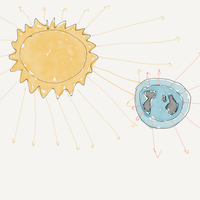What to expect
This topic is quite unusual. Rather than having lots of abstract concepts (like force or potential difference), the physics you have studied so far will help you to understand some big real-world issues.
It's all about flow!
After studying this topic, you should be able to:
- Explain the processes of electricity production and consumption
- Discuss the relative advantages and disadvantages of renewable and non-renewable sources
- Describe the features involved in nuclear power generation and safety
- Explain how the greenhouse effect results from greenhouse gases

Key questions
What does a power station do?
Heat engines convert thermal energy into mechanical work. When water is boiled to produce steam, these gas particles exert a pressure on the walls of their container. The force exerted can be converted into rotational kinetic energy (a form of mechanical energy) using turbine blades. When a conductor (such as a wire) moves in a magnetic (B) field, the electrons in it experience a force. The overall effect of this is an electro-motive force (ϵϵ), which is a potential difference converting an energy source in to electrical energy. This how the generator section of a power station works, converting mechanical energy into electrical energy. Find out more.
What are the sources of electricity?
A fuel is any substance that contains chemical or nuclear energy that can be harnessed to produce heat energy. Find out more.
Biomass, solar, hydroelectric, wind and tidal are examples of renewable sources. Find out more.
Is nuclear energy safe?
In a chain reaction, more neutrons are produced by a nuclear fission reaction than are needed to react. This is a good thing - it is essential that the nuclear reaction rate is maintained for ongoing electricity generation. An uncontrolled chain reaction is used in nuclear weaponry. If the critical mass is exceeded or if the rate of reaction needs to decrease, control rods can be lowered into the reactor to absorb neutrons completely. A typical material used is boron, as it has stable nuclei. Find out more.
What is the solar constant?
The intensity of the Sun's radiation landing on the Earth is 1388 Wm-2, known as the solar constant. Find out more.
What is the greenhouse effect?
Radiation entering the Earth's atmosphere increases in wavelength (tending towards infrared) when it reflects off the Earth's surface. Greenhouse gases absorb this infrared radiation on its way back out to space. However, gas molecules do not discriminate when re-emitting this radiation, and so a significant proportion returns to Earth. Statistically therefore, the Earth increases in thermal energy over time and global temperatures rise. Find out more.

Energy sources
The picture gives away the source of almost all of our energy - the sun. This might be obvious for solar cells, but what's the link between the sun and other energy resources?

Global thermal energy transfer
This concluding topic is a bit of everything and is a great check of so much that you have already studied.


 Twitter
Twitter  Facebook
Facebook  LinkedIn
LinkedIn